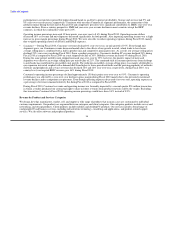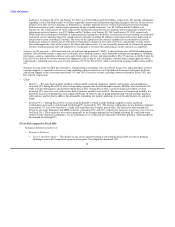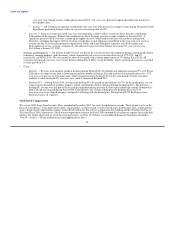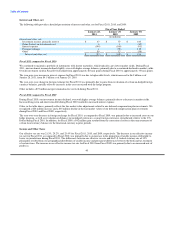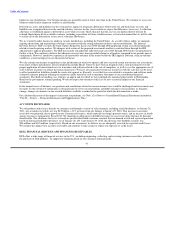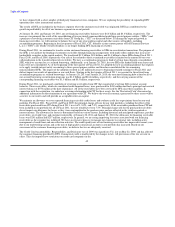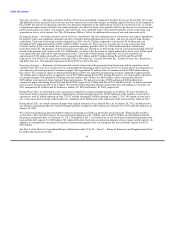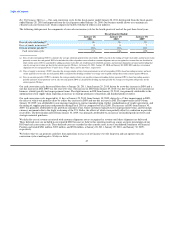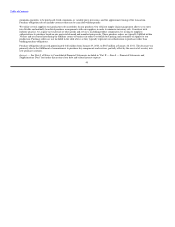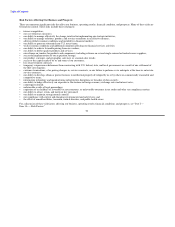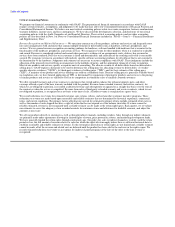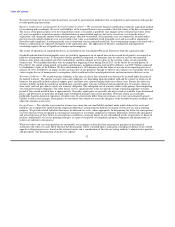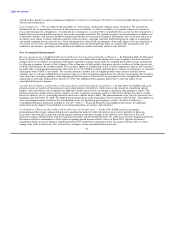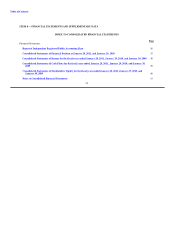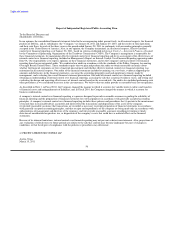Dell 2010 Annual Report Download - page 50
Download and view the complete annual report
Please find page 50 of the 2010 Dell annual report below. You can navigate through the pages in the report by either clicking on the pages listed below, or by using the keyword search tool below to find specific information within the annual report.
Table of Contents
Operating Activities — Operating cash flows for Fiscal 2011 increased slightly compared to the prior fiscal year. Fiscal 2011 net income
and deferred revenue increased year-over-year, but were offset by less favorable changes in working capital. For Fiscal 2010 compared to
Fiscal 2009, the increase in operating cash flows was primarily attributable to the improvement of our cash conversion cycle, as a result
of operational improvements related to our vendor programs, the effects of which were partially offset by the decrease in net income and
growth in financing receivables. Our negative cash conversion cycle combined with revenue growth typically results in operating cash
generation in excess of net income. See "Key Performance Metrics" below for additional discussion of our cash conversion cycle.
Investing Activities — Investing activities consist of the net of maturities and sales and purchases of investments; net capital expenditures
for property, plant, and equipment; principal cash flows related to purchased financing receivables; and net cash used to fund strategic
acquisitions. Cash used in investing activities during Fiscal 2011 was $1.2 billion compared to cash used of $3.8 billion and cash
provided of $177 million during Fiscal 2010 and Fiscal 2009, respectively. The year-over-year decrease in cash used in investing
activities for Fiscal 2011 was mainly due to lower acquisition spending, partially offset by a $430 million purchase of financing
receivables from CIT. The purchase of these financing receivables has allowed us to substantially end our servicing relationship with CIT
related to the previous joint venture in the U.S. Additionally, we believe that the return on capital generated by these assets will be equal
to or higher than that achieved by other financing activities. Cash used to fund strategic acquisitions, net of cash acquired, was
approximately $376 million during Fiscal 2011 compared to $3.6 billion and $176 million during Fiscal 2010 and Fiscal 2009,
respectively. Our Fiscal 2011 acquisitions consisted of Kace Networks, Inc., Ocarina Networks Inc., Scalent Systems, Inc., Boomi, Inc.,
and InSite One, Inc.. Our principal acquisition in Fiscal 2010 was Perot Systems.
Financing Activities — Financing activities primarily consist of proceeds and repayments from borrowings and the repurchase of our
common stock. The year-over-year decrease in cash provided by financing activities for Fiscal 2011 was mainly due to the repurchase of
our common stock and repayment of commercial paper. We repurchased 57 million shares of common stock for $800 million during
Fiscal 2011. The amount of shares we purchased during Fiscal 2010 was immaterial to financing activities compared to approximately
134 million shares repurchased at an aggregate cost of $2.9 billion during Fiscal 2009. During Fiscal 2011, net cash used for repayment
of commercial paper with maturities of both greater than and less than 90 days was $496 million, which was partially offset by
$305 million in net proceeds from structured financing programs. We had net proceeds of $396 million and $100 million from
commercial paper sales during Fiscal 2010 and Fiscal 2009, respectively. During both Fiscal 2011 and Fiscal 2010, we had net proceeds
from issuance of long-term debt of $1.5 billion. We had $4.8 billion principal amount of long-term notes outstanding as of January 28,
2011 compared to $3.3 billion and $1.8 billion at January 29, 2010 and January 30, 2009, respectively.
During Fiscal 2011, we entered into a new agreement to expand our commercial paper program to $2 billion. We have $2 billion of
senior unsecured revolving credit facilities supporting the commercial paper program. Our $2 billion of credit facilities consist of two
agreements, with $1 billion expiring on June 1, 2011, and the remaining $1 billion expiring on April 2, 2013. We intend to enter into a
new senior unsecured revolving credit facility for a minimum of $1 billion prior to the expiration of the current facility in Fiscal 2012.
During Fiscal 2011, we issued commercial paper with original maturities of less than 90 days. As of January 28, 2011, we did not have
any amounts outstanding under the commercial paper program compared to $496 million as of January 29, 2010, and $100 million as of
January 30, 2009.
We issued structured financing-related debt to fund our financing receivables as previously discussed in the "Financing Receivables"
section above. The total debt capacity of our securitization programs is $1.4 billion, and we had $1.0 billion in outstanding structured
financing securitization debt as of January 28, 2011. During Fiscal 2011, we renewed one of our fixed-term securitization programs and
increased the debt capacity by $100 million. We replaced the other fixed-term securitization program with no change in debt capacity. In
addition, we expanded our existing revolving loan securitization program with a new program that increased debt capacity levels by
$150 million.
See Note 5 of the Notes to Consolidated Financial Statements under "Part II — Item 8 — Financial Statements and Supplementary Data"
for further discussion of our debt.
46


